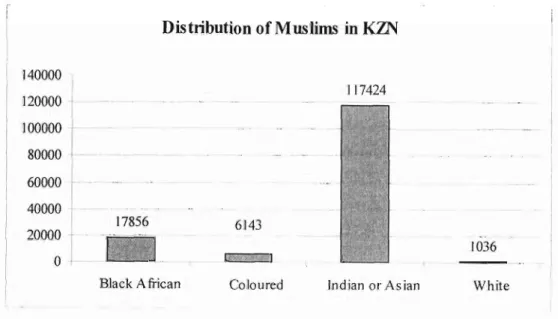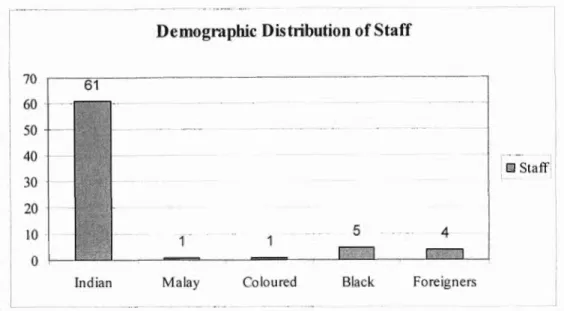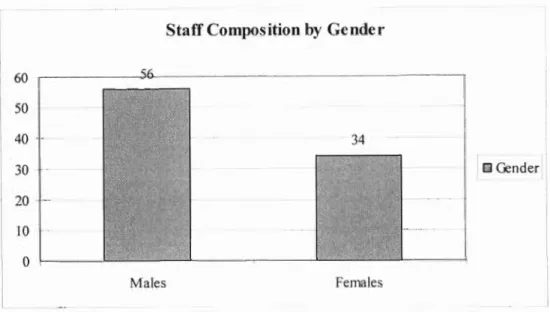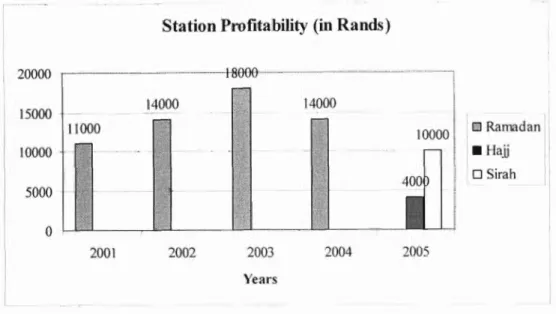The study evaluated the level of community participation in the ownership, management, programming and other aspects of Radio Al-Ansaar, a Muslim community radio station based in Durban, KwaZulu-Natal. In addition to examining the level of community participation in Radio Al-Ansaar, the article assesses the economic viability of the station.
AMARC 3. ANC
Rationale for the Study
This study will add to the aforementioned body of research on religious community radio stations. This goes against the ethos of community radio; a medium that should be inclusive.
Context of the Study
Therefore, as alluded to in the previous sub-section, the study examines whether Al-Ansaar acts as a space for facilitating inter-Muslim dialogue. It looks at whether the entire Muslim community in the province of KwaZulu-Natal has meaningful access to Radio Al-Ansaar.
Dissertation Approach
Chapter four presents a discussion of the extent of community ownership in radio ownership and governance. The study concludes with a summary of the results and conclusions discussed in section B.
Introduction
The problematic of Identity
Legitimation of identity is enacted by the dominant institutions of society to extend and rationalize their dominance over social actors, as would have been the goal of the Nationalist Party government when it embarked on a program of racial identity restructuring as part of its segregationist ideological campaign. in apartheid South Africa. Resistance identity is generated by those actors who are in positions devalued and/or stigmatized by the logic of dominance, thereby building trenches of resistance and survival on the basis of principles different from or opposed to those that permeate society's institutions.
Muslim Identity
- Ummah: The 'Community'
- Shari ah
What is required of the community as a whole is also required of each individual member. 34; The Muslim people always strive for a better and better implementation of the Shariah on their present and future affairs” (Sardar, 2003: 64).
Muslim Identity in the South African Context
- Early History of 'Indian' Muslims
- The Turning Point
- Democratic Era
They came to see themselves as South African Muslims and members of the global Muslim community. New organizations were formed with the emergence of a progressive opponent of the ulema and the latter's monopoly in the field of interpretation, and their religious parochiality was called into question (Gunther, 2003: 6).
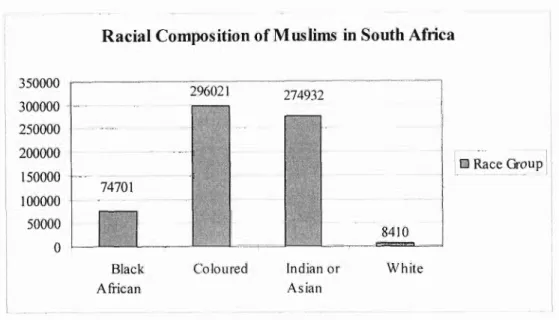
Muslim Media Theory
- Muslim Media in South Africa
- Print media
Al-Qalam and Muslim Views were one of the key channels through which information continuously flowed (Haron, 2001b). The Majlis, Al-Jamiat and Al-Rasheed provide a voice for various strands of Deobandi schools of thought.
Conclusion
Theories underpinning the community radio in which this study is involved are discussed in this chapter. The history, role and governance of community radio in South Africa is also discussed in this chapter.
Principal Theories of the Research Project
- Democratic-Participant Theory
- Another-Development Theory
- Political Economy and Media Economics
In this regard, Michel Delorme, former President of the World Association of Community Broadcasters (AMARC), states that community radio is neither an expression of political power nor an expression of capital (1990: 3). It is an expression of the population, an act of participation in the process of community creation.
The Role and Governance of Community Radio
- Community Radio
- Community Radio: The South African Case
- South African Broadcast Legislative Framework
- Historical Account of Community Radio in South Africa
- A Decade Later
Local radio in South Africa is rooted in the political and cultural struggles of the 1980s. At this conference, the essence of the South African left's vision of local radio was put forward.
Conclusion
CHAPTER THREE
THE METHODOLOGICAL FRAMEWORK
Introduction
Research Methodology
- Study Data Requirements
- Primary Data Sources
- Secondary Data Sources
These conversations took place both on the radio station and in social settings outside the station and were not recorded. In addition, the interviewees were asked to further elaborate, clarify and/or justify part of the station policy.
Research Procedure, Data Management and Analysis
As previously mentioned, Radio Al-Ansaar's documentation such as the station's organogram, the list of advisory board members, license application documents, advertising rate sheets, financial reports, policy documents and program schedules were referred to in order to gain an understanding of how the station is managed as well as its relationship with the community.
Researcher's Positioning
It was important for the researcher to constantly reflect on the purpose of the study, which was to ascertain whether the station's practices bode well for its future as a potential permanent Muslim radio station. The researcher ran the risk of being accused by the station management of exposing the radio's errors of malice.
Conclusion
The researcher had to prevent preconceived notions about the station and personal ideological attitudes about Islam from influencing the research methods, procedure and analysis. Despite the intention to be balanced, the researcher was very aware that the selection of interviewees and the quotes selected to substantiate the arguments made is not a mechanical exercise.
Introduction
Radio Al-Ansaar Contextualised
- Background to Al-Ansaar's Initial Licence Application
- Mission Statement and Objectives of Radio Al-Ansaar
Initially, Al-Ansaar gave the seed money for Radio Al-Ansaar. [it] will never get into trouble because of the support of Al-Ansaar [foundation]. The mission statement and goals clearly indicate that Al-Ansaar Foundation perceives radio as a tool used to shape a particular Muslim identity.
Ownership and Management Structure of Radio Al-Ansaar
The management board of the Al-Ansaar Foundation appointed all the board members of the radio station. Al-Ansaar [Foundation]'s management is a non-profit trust of eight members and they are independent from the [Al-Ansaar Foundation] mandate.
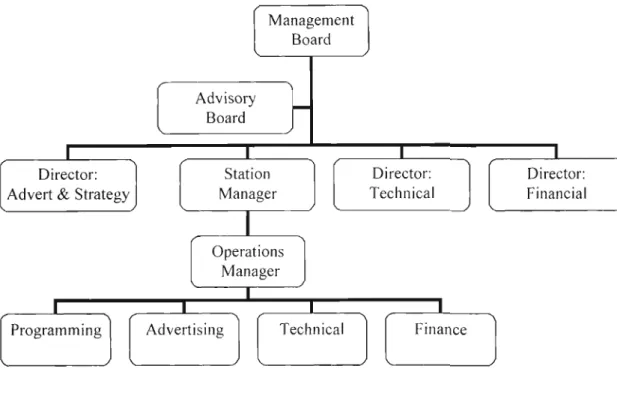
Conclusion
The Voice, a Muslim community radio in Johannesburg, all hold the ideological position advocated by the station. Yet very unlike Radio Islam, The Voice, which is owned by the MYM, supports a progressive understanding of Islam.
Introduction
Recruitment Drive
Further evidence of this drive is that some volunteers noted that they had been persuaded to participate by the Station Manager and also mentored by him. The Station Manager said that they "operate at strange times of the year [and] it is very difficult to get people to leave work and join us, but alhamdulillah for the last seven or eight years of our broadcast we managed to retain the listening audience and managed to maintain the vitality of the radio station" (Interview, September 7, 2005).
Staff Profile
- Race, Nationality and Socio-Economic Determinants
- Gender as a Determinant
- Religious Persuasion and Ethos as a Determinant
The quote below further indicates the opposition to women's participation that the station faces from some religious leaders, as mentioned in the case of Radio Islam. It seems that the non-Muslim presenters are not uncomfortable with the Islamic character of the channel.
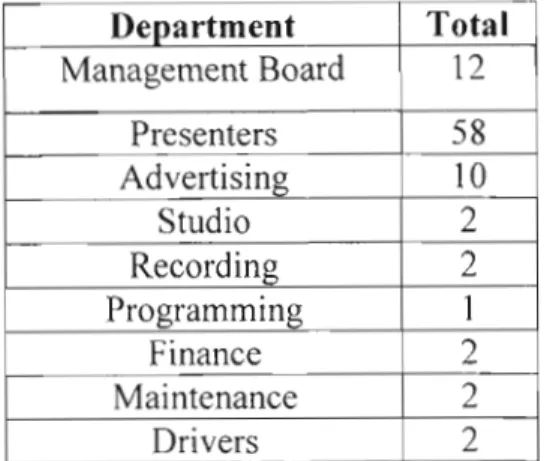
Training as Empowerment
The training and experience gained at the station is used as a springboard to permanent radio broadcasting opportunities. Once the station has its permanent status, further research will be required to determine whether the overall level of engagement has been consistent or has been so in the past due to the temporary nature of the project over many years.
Remuneration as Incentive
The above comment is reinforced by the comments of one of the presenters who said he worked voluntarily and would never consider payment. Commenting on why she was no longer with the station (apart from her move to Johannesburg), she said: "I'm not sure if the station would have wanted me to work for them this year - I certainly wasn't contacted by everyone" (Interview, September 26, 2005).
Feedback to Staff
The commentary below further highlights the ongoing attempts by religious authorities to control radio output and the interventions of management to avoid their wrath. An example is when one of the presenters of Teen Zone, who at that time (2005) was working for the World Assembly of Muslim Youth (Wamy), planned to discuss youth leadership in the program.
Conclusion
Her co-presenter informed her that the Station Manager had instructed them not to mention Wamy's Youth 'Leadership Programme' on air. On a positive note, volunteers are given certificates in recognition of their contribution and one volunteer from each department is selected and given an award for excellence30 based on various factors determined by the governing board. "As part of the process to become more effective and raise our level of service delivery, it has been decided that we should give awards for excellence to the various divisions within the radio stations" {Al-Ansaar Policy Guidelines, 2001).
Introduction
Programming Mission
As argued in chapter five, his use of the word “controlled” is a misnomer because community participation in programming at Al-Ansaar is encouraged, but within strict parameters. As mentioned, this is clearly different from the enormous amount of on-air publicity given to Al-Ansaar Foundation's fundraising initiatives.
Programming Evaluation 34
- Programmes on Islam and Spirituality
One of the short-term projects was the launch of Al-Ansaar's 'hijab campaign' during the 2005 Ramadan broadcast. An example of the type of controversy this program caused occurred in the last week of the 2005 Ramadan broadcast .
Phone-ins as Participation
34; Very often the presenters are very accommodating and they also take the suggestions from the public and include them in their program." It can be downloaded from the Al-Ansaar Foundation website and mailed, emailed or faxed to the station.
Outdoor Broadcasts as Participation
During the final week of broadcasting, the presenters encourage listeners to call, text, fax or email the station their votes for their favorite programs and presenters and the reasons for their choice. At one end of the spectrum, they approach the Sunni Jamiat-ul-Ulama to cover their milaad* functions.
Conclusion
Introduction
Marketing
Funding Mechanism Evaluation 46
- Advertising and Sponsorship
- Advertiser, Sponsor and Product Profile
- Advert Production and Format
- Broadcast Method
- Other Revenue Sources
- Investment of Profits
As referred to, "Radio Al-Ansaar is fully funded by advertising and sponsorship" (Interview with S Karwa, October 2005). Another source of funding is in the form of pledges on the radio's Niteline program from the community to the Al-Ansaar Foundation for its various projects, especially its scholarship fund.
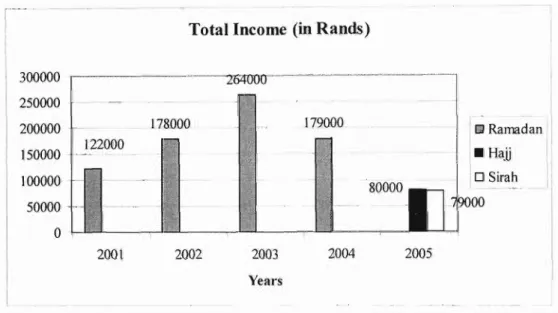
Conclusion
Al-Ansaar empowers certain members of the community in media-related, marketing, sales and administrative skills. The station, as discussed in Chapter Four, is owned by a non-profit organization, the Al-Ansaar Foundation.
Secondary Sources
Dangor, S, (2004) 'Negotiating Identities: The Case of Indian Muslims in South Africa.' In Jacobsen, K.A. eds) South Asians in the Diaspora. Ibrahim, Z (2004) 'The road to community radio' in Rhodes Journalism Review. 1991) 'Communication and the new paradigm for development'.
APPENDICES
Radio Listening: Commercial Stations
Yes AGM PROGRAMMING Unitra Community Radio adheres to the format of 60% talk and 40% music as set out in Clause 2 of Schedule C of the License Conditions. Yes Broadcast hours COMMUNITY English, IsiXhosa, Isizulu and SeSoto speaking community of the university campus and surrounding area.
COMMUNITY STATION SUMMARY STATION AUDIENCE - 7 DAYS
ADULTS
ORGANOGRAM
BOARD OF MANAGEMENT
MS A AMOD
PRESS RELEASE
POPULAR RADIO STATION BACK ON AIR RADIO AL- ANSAAR
Popular Radio station back!
Introduce discussions on the value, importance and need for the revival of the Sunnah. amp;.Hadith in our time. In addition, the Radio station will focus on the usual I s l a m i c d e v e l o p m e n t a l content on the radio station.
RADIO
7 OCTOBER TO 5 NOVEMBER 2005
Phone: 031-208 1601
THIS PROGRAM IS BROUHT TO YOU BY
TEXTRIM
RADIO AL-ANSAAR MANUAL
PROGRAM PROFILE
LIVE PROGRAMS DURING SIRAH BROADCAST
On behalf of the directors and management of Al-Ansaar Foundation, we wish you a warm welcome to our family. We hope that this will be the beginning of a long and lasting relationship between us and that this relationship will be beneficial to us and the Ummah at large.
AL-ANSAAR BOARD OF DIRECTORS
RADIO AL ANSAAR - JUNE BROADCAST
Contents of this Broadcast
SUGGESTED SLOGANS THAT MAY INSPIRE THE LISTENERS
IP ONE
INTRODUCTION
1-Ansaar Activities
PRESENTERS
RADIO AL-ANSAAR STRIVING FOR CXr LLENCE
Q: So radio still has relevance despite other competing and advanced technology?
So in my opinion they're really complementary and that's why you'll find all the radio stations, talk radio stations, except, not music radio stations, if you look at their programming content, you'll find that their peak times and their low times, their prime times usually occur when people don't really go to watch television. But say between 7 and 9 o'clock is low rate because of all the soap operas on television, people are at home, they watch, this is our modern society now.
Q: Explain Al-Ansaar's ownership
Q: Is the radio a community entity?
In one year we had the services of a university lecturer, Suhaima Hussein, who conducted research on the influence of Radio Al-Ansaar. So this is the way in which, I'm not sure about other radio stations, but this is the way in which Al-Ansaar campaigns.
Q: How else do you engage the community?
In terms of management and finance, like I said, you have to have employees because it's a very professional area that you have to have, and that's why it's set for employees, you're paying the person. In terms of programming, anyone can come in and contribute to us, but we don't have any formal structures for the wider community.
Q: Participation is a key principles of community radio, please elaborate on this aspect
Then we moved to the milaad function, the other spectrum of the community and we had about 3 or 4 milaad functions, naath programs in different communities, from Chatsworth, from Alpine Road and from other centres, so there was an open line of communication. So there it doesn't necessarily have to come from the community, it can be outside the community, for example it can even be a non-Muslim who comes in and helps us with the finances and control and some of the management. of the radio station.
Q: What do you see Al-Ansaar's role as?
Q: Please comment on the governance of the radio station
Why would they do this, they know that the listenership is high and the radio station has influence, so we define it as collaboration. The other four administrators play a secondary role at the radio station.
Q: The trustees are all male and make up the board of management. Please comment
Q: Who appointed the radio station board of management?
Q: Have the members been nominated by the community?
Ummah newspaper for the community we serve, and we also make the announcement on the radio station.
Q: Would you agree that this is a shortcoming of the station?
Q: Tell me about the Advisory Board
The advisory board consists of 10 members and they are from the various theological bodies in the country, the Sunni Jamiat ul Ulema, the sufi group, the university, such as Prof Suleman Dangor and so on are represented there and we do not have the MJC here, but we would have had them on board and we have some members of the board of Al-Ansaar who are part of the advisory board.
Q: Explain how the programming works
Q: Do you have statistics on the number of phone calls programmes receive?
For example, let's say that a children's program will have a high number of calls because if 50 children are listening, 40 of them would want to talk, but if 50 adults are listening to the program, only 10 of them would want to call.
Q: Do you know off-hand how many listeners Al-Ansaar has?
Q: Does the station reach out to non-Muslims as well?
Q: What do you think is the drawcard of the station?
Q: Which is the most challenging age-group to reach out to?
Q: How many staff do you have? And where do you source them?
Q: Are the staff compensated?
Q: Why do you think experienced broadcasters joined the station?
Q: What criteria is used in terms of payment?
Q: Do you find that your volunteers are poached by your competitors?
Q: You seem to resent this
Q: Do you manage to reach out to non-Indian Muslims?
Q: What about people of other races?
But frankly, we don't look at presenters in terms of what language they speak, as long as they are able to present the programme. So the selection is not based on what language they speak or what race you are, if you are able to do that then we will bring you in so they got the criteria clear.
Q: Should there be a form of affirmative action?
If you ask whether we consider participation of the Malay community to be optimal, I would say definitely not, we need to move towards embracing these communities because they are part of the community and they should have a voice.
Q: Besides ICASA what other bodies influence governance?
Q: Your policies and ideology seem to be aligned to those of the ulema. Please comment
Q: Do you bring other Muslim organisations on board?
We have done this with several organizations, some have come on board, others have not, like IEOSA has not come on board. This saves on two things, one our responsibility is reduced, we will engage in skills development and b) we are giving organizations the opportunity to showcase themselves as well as bring input from their community sector.
Q: If a listener is unhappy with something how do you deal with it?
Q: What is your role at Radio Al-Ansaar?
Q: Who selects programmes?
Q: Does the community come up with programme suggestions?
Q: Are your topics of interest only to Muslims?
Q: If listeners complain about a programme or presenter how do you respond?
Q: Do you feel every year has been a progress on the previous year's broadcasts?
Q: Would this be maintained if it were a fulltime station?
Q: What has been the community's response to non-Muslim presenters?
Q: Do you think the non-Muslim presenters have fitted into Al-Ansaar's ethos?
Since we introduced non-Muslim presenters, we have found that we have many non-Muslims listening to our station. So we have a lot of cases like this where sometimes people accidentally get hooked into the station and they stay with and we even have, for example, we have an agreement with the Rising Sun.
Q: Do you have partnerships with other media?
For example, when we did an outdoor broadcast in our last sirah broadcast, there was a white lady, a Christian lady who was driving by and she was trying to fix her radio and she came across Radio Al-Ansaar and she called to find out what station it is about, she loved the music, naaths and qasidas we play and said she won't switch off until the end of the broadcast.
Q: Why do you do outdoor broadcasts?
Q: Do you think they got the idea from Al-Ansaar?
Mmarine World, we had broadcasts from milaads, we had broadcasts from naath programs that the community had informed us about, we made the necessary arrangements and we broadcast the programs live.
Q: What has the community's response been to outdoor broadcasts?
Q: Please comment on your broadcasts from different mosques?
Q: Have programme ideas been taken by stations such as Lotus?
Q: Which programmes do you consider as most popular?
In fact, so often we can't take all the calls, we can't handle the incoming calls.
Q: Do you have a theme for each broadcast?
Q: In the past you had a theme for each broadcast, do you still have these?
Q: Do you broadcast in other languages besides English?
APPENDIX ELEVEN (C): INTERVIEW TRANSCRIPT Interviewee: Farhana Kader - Radio Al-Ansaar Advertising Manager Date: Tuesday, September 13, 2005.
Q: How long have you been working in the advertising department?
Q: Which programmes do advertisers consider as most popular?
